#Indo-China Relations
Explore tagged Tumblr posts
Text
sanghis are so funny. “hindus need to stand up for tibet because they are our dharmic brothers and sisters” hindus should stand up for tibet because imperialism is bad.
#that being said it’s not like i’d have any luck telling that to the akhand bharat crowd#if indo-china relations weren’t bad then i bet the akhand bharat crowd would be bending over backwards to justify chinas imperialism#indpol#desi tag#desiblr
211 notes
·
View notes
Text
India US China Relations: New Game Plan
Navigating the New Great Game: India-US-China Relations and New Delhi’s Strategic Horizon The Shifting Global Chessboard: US-China Tensions and the Indo-Pacific Fulcrum The 21st century is increasingly defined by the complex and often contentious relationship between the United States and China. This rivalry is not just a simple bilateral issue. It is redrawing the geopolitical map. The…
#Aksai Chin#Belt and Road Initiative#China India Border#China Military Expansion#geopolitics#Himalayan Geopolitics#India Foreign Policy#India US China Relations#Indo-Pacific Strategy#international relations#newspatron#Quad Alliance#Strategic Autonomy India#US China Tensions
0 notes
Text
Tensions Rise Again in the West Philippine Sea
In an urgent commentary, Dindo Manhit stated, “No to silence, submission, subservience,” in his April 12, 2024 article. He highlighted China’s aggressive actions in the West Philippine Sea. Water cannons and bullying tactics were putting pressure on the Philippines. He argued that the country must stand strong against these threats. His words rang true as the region became a focal point for…
#Chinese aggression#Dindo Manhit#Geopolitical tensions#Indo-Pacific Security#Maritime Security#maritime sovereignty#Naval Operations#Philippine Coast Guard#Philippines defense#Scarborough Shoal#Second Thomas Shoal#Seismic Activity#South China Sea#Taiwan tensions#US-Philippines Relations#West Philippine Sea
0 notes
Text
ताइवान ने मोहम्मद यूनुस को लताड़ा: 'चीन के सामने झूठ मत बोलो, हम स्वतंत्र देश हैं'
Taiwan News: ब���ंग्लादेश की अंतरिम सरकार के मुखिया मोहम्मद यूनुस की हालिया चीन यात्रा ने ताइवान को नाराज कर दिया है। यूनुस ने 27 से 29 मार्च 2025 तक बीजिंग में चीनी राष्ट्रपति शी जिनपिंग से मुलाकात की और एक संयुक्त बयान में ताइवान को चीन का हिस्सा बताने की बात कही। इस पर ताइवान के विदेश मंत्रालय ने कड़ा ऐतराज जताते हुए यूनुस को झूठ और भ्रम फैलाने से बचने की नसीहत दी है। ताइवान ने साफ कहा कि वह एक…
#Bangladesh interim government#China Bangladesh joint statement#China influence Bangladesh#Indo-Pacific peace#Mohammad Yunus China visit#One China principle#taiwan#Taiwan Bangladesh relations#Taiwan Foreign Ministry#Taiwan independence#Taiwan sovereignty
0 notes
Text
India’s Possible Entry into ‘Squad’ Alliance to Strengthen South China Sea Security
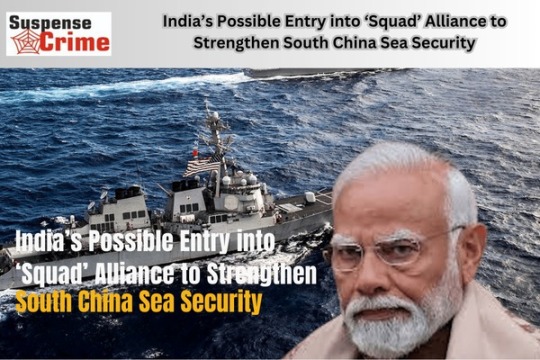
India May Join Strategic Military Alliance Against China’s Influence
India is considering joining the emerging ‘Squad’ military alliance, which includes the United States, Australia, Japan, and the Philippines. This coalition is designed to counter China’s expanding dominance in the Indo-Pacific region, particularly focusing on security in the South China Sea.
The alliance aims to bolster regional defense capabilities through intelligence sharing, joint military exercises, and coordinated operations among its member nations.
Philippines Backs India’s Inclusion in the Squad
Although the Squad is an informal alliance, its member countries have already been conducting joint maritime operations within the Philippines’ Exclusive Economic Zone (EEZ) in the South China Sea since last year.
The Philippines has been a strong proponent of India’s inclusion, citing New Delhi as a key partner in countering China’s aggressive expansion in the region.
Speaking at the Raisina Dialogue in New Delhi, Philippines Armed Forces Chief General Romeo S. Brawner expressed a strong alignment of interests between India and the Philippines. He stated:
“Alongside Japan and our other allies, we are looking to expand the Squad to include India and possibly South Korea. India and the Philippines share a common concern—China’s influence. I am not afraid to say that China is our common adversary.”
China’s Aggressive Claims in the South China Sea
China claims almost complete control over the South China Sea, a vital global trade route worth over $3 trillion annually. However, these claims violate the sovereignty of multiple nations, including:
Philippines
Indonesia
Malaysia
Vietnam
In 2016, the Permanent Court of Arbitration ruled against China’s claims, but Beijing has continued to ignore the ruling while increasing its military presence in the region.
India’s Role in Quad and Potential Squad Alliance
India’s possible integration into the Squad aligns with its existing role in the Quadrilateral Security Dialogue (Quad)—a security alliance with the US, Japan, and Australia focused on ensuring a free and open Indo-Pacific and countering China’s strategic expansion.
With tensions rising in the South China Sea, India’s inclusion in the Squad alliance would further strengthen its regional security commitments and expand its strategic influence.
Philippines Expanding Military Ties with India
The Philippines is deepening its defense cooperation with India, particularly in missile technology.
The Philippines has already acquired the BrahMos missile system from India.
Additional components of the BrahMos system are scheduled for delivery.
General Brawner praised the missile system’s effectiveness, emphasizing its importance in deterring Chinese aggression in the South China Sea.
As geopolitical tensions escalate, India’s participation in the Squad could redefine the regional power balance, reinforcing efforts to curb China’s military expansion and secure freedom of navigation in the Indo-Pacific.
#India Squad Alliance#South China Sea Security#India Military Alliances#China Indo-Pacific Strategy#US-India Defense Relations#Quad and Squad#China vs India Military#Indo-Pacific Security#Philippines Defense Deals#BrahMos Missile System
1 note
·
View note
Text
The Curious Case of Trump Not Inviting PM Modi: A Diplomatic Snub or Strategic Move?
Former U.S. President Donald Trump has long been a figure who captivates global attention with his unpredictable decisions. From his polarizing political stances to his unconventional diplomatic moves, Trump’s actions rarely fail to spark widespread discussion. The latest episode to make headlines revolves around Trump’s decision to extend invitations to Chinese President Xi Jinping and Indian industrialist Mukesh Ambani, while notably excluding Indian Prime Minister Narendra Modi from his upcoming inauguration ceremony. The event in question is Trump’s inauguration on January 20, 2025, when he will be sworn in as the 47th President of the United States. This surprising omission has sent ripples through political circles, sparking debates about the implications for Modi’s global stature and the political narrative in India.
For a leader like Modi, who has worked diligently to build a global persona as a strong, respected figure, this exclusion is not a trivial matter. Modi has worked hard to forge ties with Trump, most notably through the 2019 "Howdy Modi" event in Houston, which saw over 50,000 Indian-Americans gather in support of both leaders. Modi’s endorsement of Trump during the event—“Abki Baar, Trump Sarkar” (This time, a Trump government)—was a rare and powerful gesture of support from a global leader. Therefore, Trump’s exclusion of Modi from such an important occasion raises critical questions: Is this a diplomatic snub, or is there a deeper, more strategic reasoning behind this move? Read more
#Trump inauguration 2025#PM Modi exclusion#U.S.-India relations#diplomatic snub#Modi Trump relationship#India China tensions#Mukesh Ambani#global politics#Trump Xi Jinping#Indo-U.S. relations#Modi international stature#political analysis#Insights on trump invitation
1 note
·
View note
Text
الخطابات والممارسات الأمريكية تجاه منطقة المحيطين الهندي والهادئ - من أوباما إلى بايدن (منظور بنائي)
الخطابات والممارسات الأمريكية تجاه منطقة المحيطين الهندي والهادئ – من أوباما إلى بايدن (منظور بنائي) الخطابات والممارسات الأمريكية تجاه منطقة المحيطين الهندي والهادئ – من أوباما إلى بايدن (منظور بنائي) المؤلف: Nourhan Aboelfadl المستخلص: تطورت استراتيجية الولايات المتحدة لإعادة التوازن نحو آسيا بشكل جوهري، خاصةً في ظل تغير للتحالفات الإقليمية في المنطقة. ولذلك يستدعي التوجه الأمريكي المتقلب…
#A Constructivist Perspective#Biden’s Indo-Pacific Strategy#China’s rise#China’s threat to the US#Indo-Pacific#Obama’s Rebalance#Trump’s Indo-Pacific Strategy#US#US construction of the Indo-Pacific.#US containment of China#US discourse#US Foreign Policy#US- Asia relations#الولايات المتحدة؛ إعادة التوازن لأوباما؛ إستراتيجية ترامب للمحيطين الهندي والهادئ؛ إست
0 notes
Text
الخطابات والممارسات الأمريكية تجاه منطقة المحيطين الهندي والهادئ - من أوباما إلى بايدن (منظور بنائي)
الخطابات والممارسات الأمريكية تجاه منطقة المحيطين الهندي والهادئ – من أوباما إلى بايدن (منظور بنائي) الخطابات والممارسات الأمريكية تجاه منطقة المحيطين الهندي والهادئ – من أوباما إلى بايدن (منظور بنائي) المؤلف: Nourhan Aboelfadl المستخلص: تطورت استراتيجية الولايات المتحدة لإعادة التوازن نحو آسيا بشكل جوهري، خاصةً في ظل تغير للتحالفات الإقليمية في المنطقة. ولذلك يستدعي التوجه الأمريكي المتقلب…
#A Constructivist Perspective#Biden’s Indo-Pacific Strategy#China’s rise#China’s threat to the US#Indo-Pacific#Obama’s Rebalance#Trump’s Indo-Pacific Strategy#US#US construction of the Indo-Pacific.#US containment of China#US discourse#US Foreign Policy#US- Asia relations#الولايات المتحدة؛ إعادة التوازن لأوباما؛ إستراتيجية ترامب للمحيطين الهندي والهادئ؛ إست
0 notes
Text
Unraveling India’s BRICS and BRI Conundrum
In a world where geopolitics often resembles a complex game of 3D chess, India finds itself pondering its next move on a board set by two ambitious projects – the expansion of BRICS and China’s Belt and Road Initiative (BRI). Imagine a chessboard, not with mere black and white squares, but a vibrant mosaic of global interests, strategic rivalries, and the occasional pawn aspiring to be a queen.…
youtube
View On WordPress
#2023#BRICS expansion#China&039;s Belt and Road Initiative#diplomatic challenges#economic alliances#economic corridors#emerging economies#geopolitical chess game#geopolitical irony#Geopolitics#global power dynamics#Global-Strategy#India&039;s-Foreign-Policy#India-BRICS relations#India-China rivalry#Indo-Pacific affairs#infrastructure development#international diplomacy#multipolar world order#Pakistan-BRICS membership#regional influence#sovereignty concerns#strategic-partnerships#Youtube
0 notes
Text
Trivia collection: Nezha in the Tang-Song period
Quick primer: Nezha originates from an Indian deity that gets incorporated into the Buddhist pantheon and imported into China via the spread of Buddhism, then becomes progressively more sinicized + Daoist-ized as a popular folk deity.
Neither his iconography nor backstories stay the same throughout this long process of localization and syncretism, and the vernacular novels that define his modern popular image come relatively late in Nezha's evolution.
This post focuses on Nezha in the Tang-Song period——when he first appeared in translated ritual texts + when the "returning his flesh and blood" thing showed up in written sources.
...
-Before we get to the defining early ritual texts, we must start with the brief mentions of Nezha/Nalakuvara in translated Buddhist scriptures.
-The earliest mention of Nalakuvara as the son of Pishamen, a.k.a. Vaisravana, appeared in the Northern-Southern dynasty translation of Buddhacharita (佛所行赞). Here, he is not refered to using transliterations that have "Na/Nezha" as its first two characters, but as Naluo Jiupo.
-In Bhaiṣajya-vastu, one section of Mūlasarvāstivāda Vinayapiṭaka (根本说一切有部毗奈耶药事), Nezha is brought up in a conversation between Sakyamuni and Ananda. Sakyamuni basically pointed at a mountain and said "100 years after my death, two brothers——Nezha and Pozha——will come along and build a temple here".
-Other scriptures described him as a Yaksha general (in 不空羂索神变真言经), a Devaraja (in 大佛顶陀罗尼), or a "ghost/demon king" (in 吽迦陀野仪轨).
I suppose you can find reasoning for all these readings in the Indo-Buddhist deity he's based on:
1)Nalakuvara the original is the son of Kubera. Vaisravana is either Kubera's epithet or his father.
2) In the Atharva Veda and Satapatha Brahmana, Kubera/Vaisravana rules over either evil spirits or Rakshas.
3) Yaksha/Raksha being among his subjects kinda carried over to the Mahabharata and Ramayana too, in which he's a wealth god who ruled over the city of Lanka, before his half-brother, Ravana, comes along and forced him to move out.
(Nalakuvara also had a wife in Ramayana. Ravana assaulted her, and he put a curse onto Ravana in response.)
4) Buddhism incorporated Kubera into their pantheon as a guardian deity under the name Vaisravana: here, he is the Devaraja of the North and lord of the Yakshas.
5) Because the Indian sources don't have a consensus on whether Nalakuvara's father is a Yaksha/Raksha or a god either, the translated scriptures also can't agree on the specific details of Nezha other than him being a guardian deity.
-It is in Tang Buddhist texts about Pishamen worship that Nezha's status as Pishamen's third son becomes more firmly established.
-However, there are actually 2 different variants of his relation to Pishamen: one said he was Pishamen's grandson, while the other said he was Pishamen's third son.
-The first variant is from Amoghavajra's translation of a ritual text, 北方毗沙门天王随军护法仪轨. In this text, he wields a halberd, "sees all four directions with his fierce eye" (尔时哪吒太子,手捧戟,以恶眼见四方), and will bonk monks and nuns over the head with his vajra club for harboring wicked and murderous thoughts.
-In this text, he is also described as a protector of kings and officials, a subduer of the wicked, and has a mantra one can recite.
-The second variant is found in two other Pishamen-related texts translated by Amoghavajra, 北方毗沙门天王随军护法真言 and 毗沙门仪轨.
-Apart from being Pishamen's third son, both texts also give him the role of pagoda-carrier. In the latter text, it is mentioned that the 21th day of every month is when he hands the pagoda back to his father.
-Another Tang source, 开天传信记, features a story where Nezha protects Xuan Lv, disciple of Śubhakarasiṃha, from a fall, introduces himself as Pishamen's son, and presents a Buddha tooth relic to the Buddhist master.
-He's described as a "youth" here, but honestly, 少年 could refer to anything between a young teen and a young adult. This story has an earlier predecessor in Ennin's travel diary, where he also mentioned Nezha giving a tooth relic to a monk.
-Finally for the Tang dynasty, there is a specific genre of Dunhuang paintings called "Heavenly King Pishamen arrives at Nezha's banquet". Usually, the painting is located on the west wall of the painting cave's antechamber.
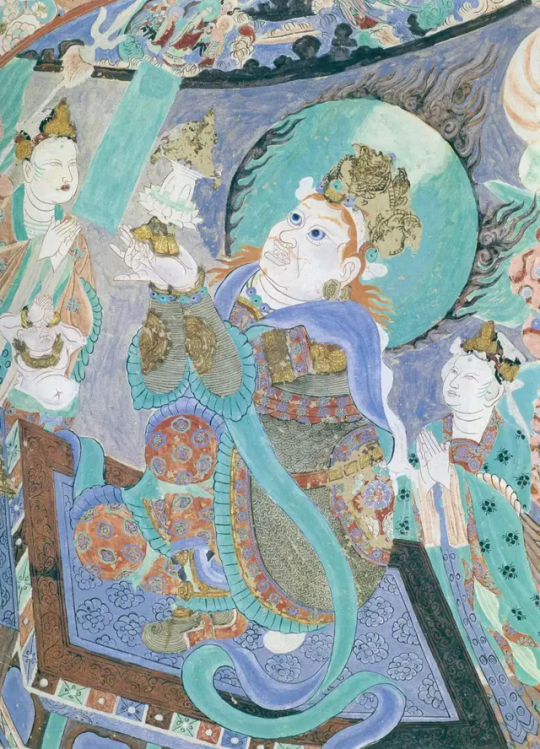
[Mogao Cave 146, main chamber ceiling, northwestern corner. Nezha is likely the small figure on the left, clasping his palms together over his head.]
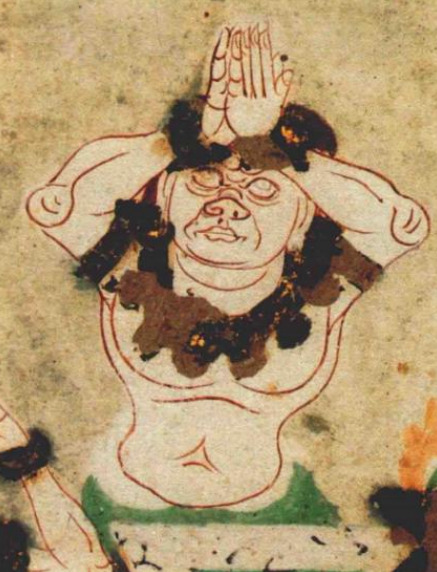
One Dunhuang text, the P.3564 Mogao Cave Merit Records from 933 CE, gives some context on the aforementioned genre: Pishamen goes to Nezha's banquet, but he either arrives late or not a lot of people show up, and Nezha gets so angry that he's ready to stab Pishamen with a sword, until Pishamen reveals that Amitabha is inside his palm and he cheers up again.
-Based on other inscriptions in Cave 72 where the "Nezha Banquet" paintings are titled as "Amitabha Enters the Pagoda and Arrives at Nezha's Banquet" and "Heavenly Lord Pishamen Invites Amitabha into the Pagoda for Nezha's Banquet", we can make some guesses about the above story.
-Perhaps Pishamen promises Nezha that guests/Amitabha will come to his banquet, no one shows up, thus Nezha gets murderously mad at him until Pishamen reveals Amitabha sitting inside his pagoda like a surprise present?
(Sidenote: later, Pishamen gets syncretized with the historical Tang general, Li Jing, and becomes a separate character known as "Devaraja Li". It wasn't a thing in the Tang-Song sources yet, though.)
-Nezha returning his flesh and bone to his parents is a thing that first shows up in Buddhist compendiums of the Song dynasty (景德传灯录,五灯会元) as a Chan riddle. Being a riddle, it just states that he returns his bones to his father, his flesh to his mother, then sits atop a lotus and preached the Buddhist laws to his parents.
-The "return of flesh & bone" may have been a derivative of Nezha's quote in the aforementioned Tooth Relic story, where he's like "I'll even give up my head and eyes, why won't I offer up [the relic]?"
-The way this riddle has been used, though, is very much centered around identity, seeing through the emptiness of the Five Skandas, and the delusion of the false self.
-There's also this Southern Song quote from 如净和尚语录 that described an opera performance scene where Nezha appeared on stage, likely performing the above narrative of "returning his flesh and bones" because he's described as taking off his clothes.
"…十二峰前上戏棚,那咤赤脱点天强。"
-Su Zhe, brother of the famous poet Su Shi, has an entire poem dedicated to Nezha. Here's a translation of the relevant lines, from Meir Shahar's Oedipal God:
The Northern Heavenly King had a son who was mad: He only venerated the Buddha—not his dad. The Buddha, knowing he was crazy and hard to be told, Ordered the father a magic stupa in his left hand to hold. Approaching the Buddha, the child bowed his head, Not unlike revering his dad.
-Aside from that, he's also known in Song sayings and poems for his wrathful demeanor——to the point of often having the adjective "Wrathful" attached to his name (忿怒哪吒).
-Fun fact, the discrepancy between Nezha having 6 arms or 8 arms appears in this period too, though 8 arms are the more commonly accepted version in textual sources.
-Lastly, a story from the Southern Song compendium Yijian Zhi mentions Daoist Master Cheng from the Mt. Mao tradition using Nezha's Fireball Spell to defeat a stone demon. This may be the first appearance of a Daoist-ized Nezha.
TL;DR: Nezha in the Tang-Song period was very much a Buddhist guardian deity who miiiight also be a Yaksha general, most well-known for his wrathful demeanor and multi-headed, multi-armed form.
The earliest mentions of the "Returning of flesh and bones" also don't have its later association with filial piety/father-son conflict, and is mostly a Chan Buddhist riddle.
Bibliography:
付方彦,《哪吒形象流变研究》
郭俊叶,《托塔天王与哪吒——兼谈敦煌毗沙门天王赴哪吒会图》
李小荣, 《那吒故事起源补考》
刘文刚,《哪吒神形象演化考论》
罗俊,《符号学视角下中国古代哪吒形象的演变》
任婧,《从无名氏到大英雄:论哪吒形象的演变与东传》
Shahar, Meir. Oedipal God: The Chinese Nezha and His Indian Origins. University of Hawai'i Press, 2015.
王彦明,《哪吒话头的禅林传播与明清小说的多元互动》
#chinese mythology#chinese folklore#nezha#nalakuvara#mahabharata#ramayana#hindu mythology#buddhism#at the risk of provoking discourse#anyone who cite “Chinese Mythology” for the Eternally 12 Myth#yet have no idea who Nalakuvara is#or Nezha's appearances in texts that precede JTTW and FSYY#deserve a good smack on their noggin'
44 notes
·
View notes
Text
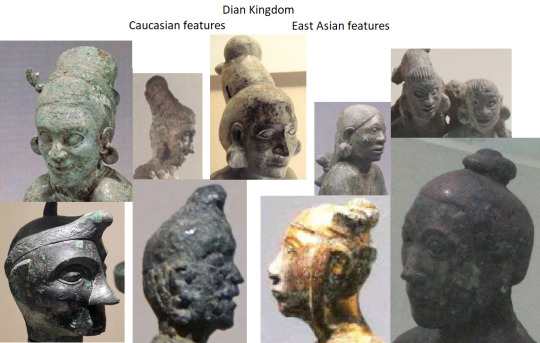

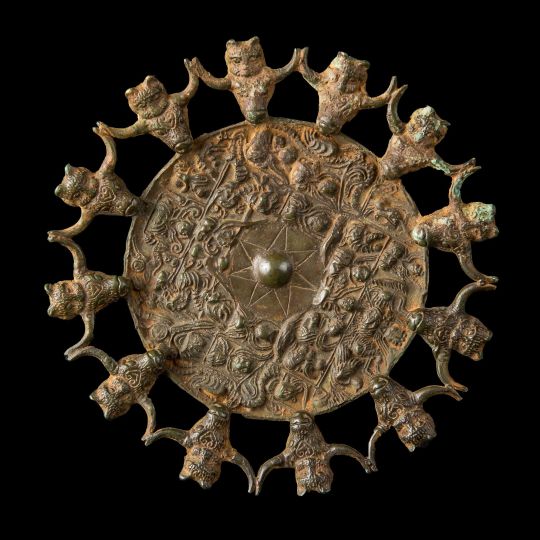


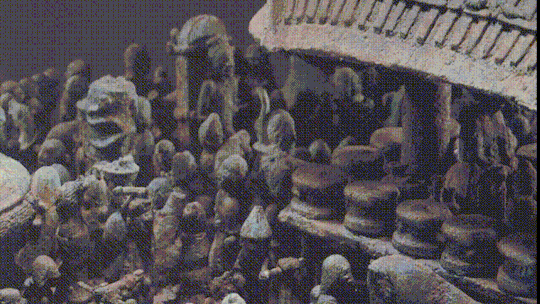

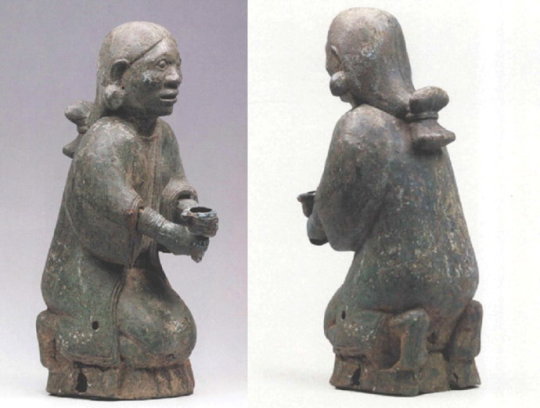
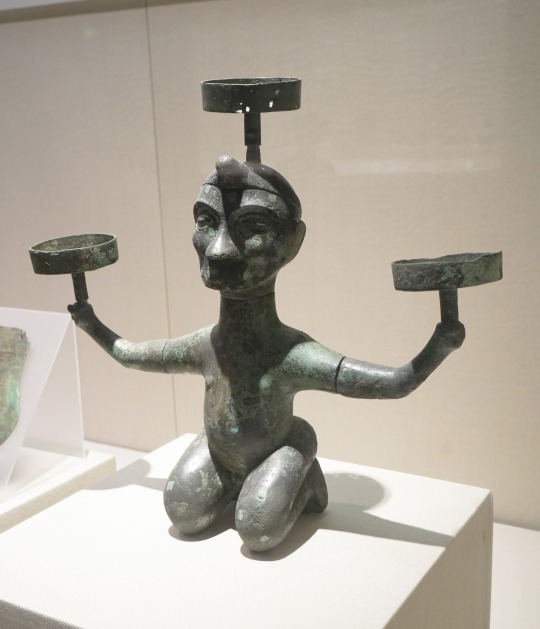
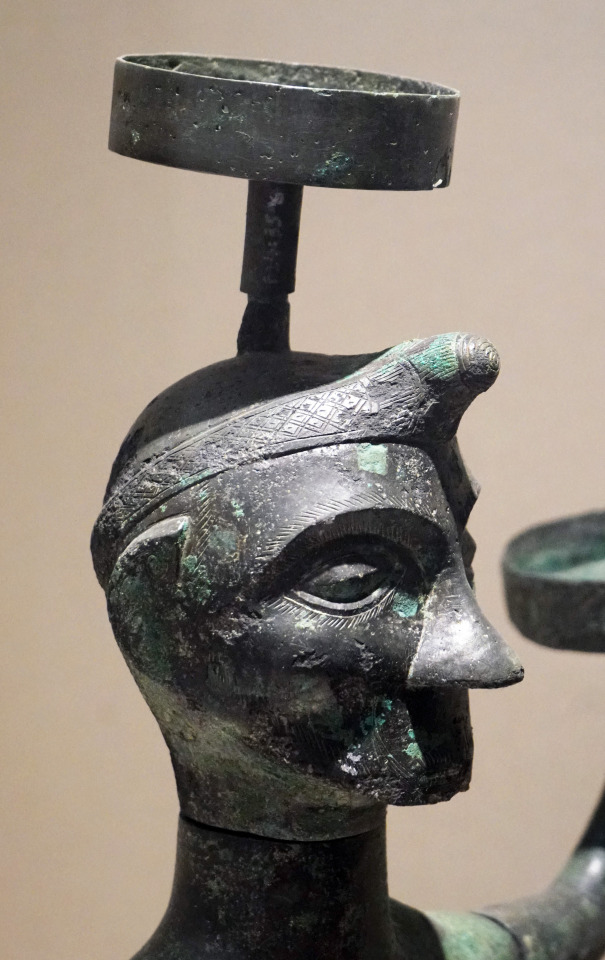

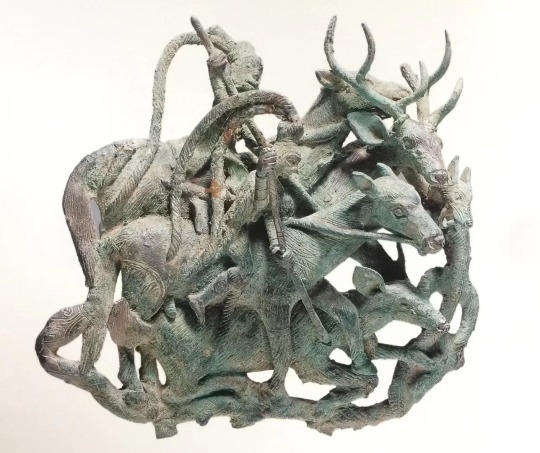




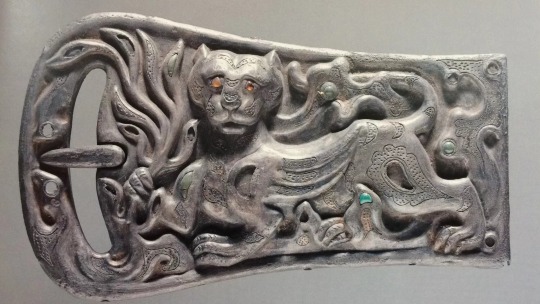
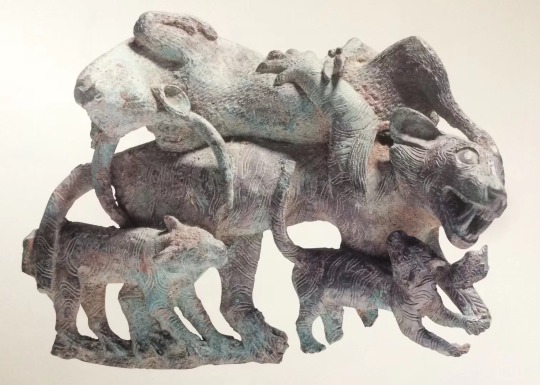

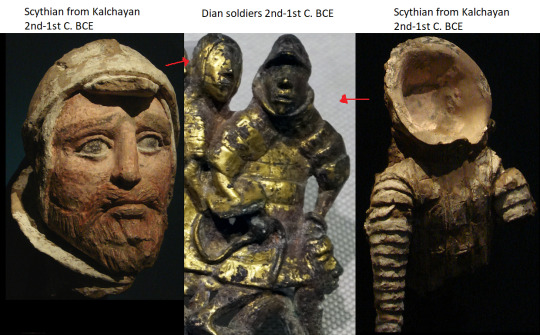
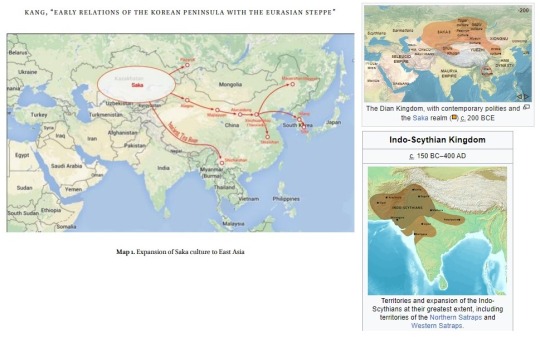
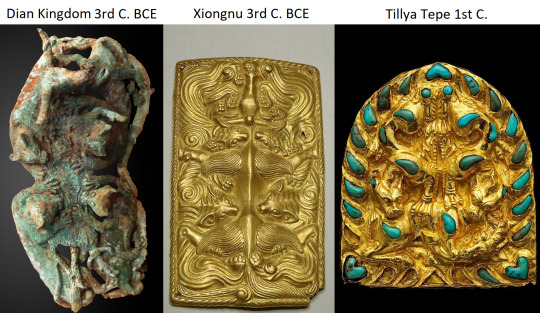

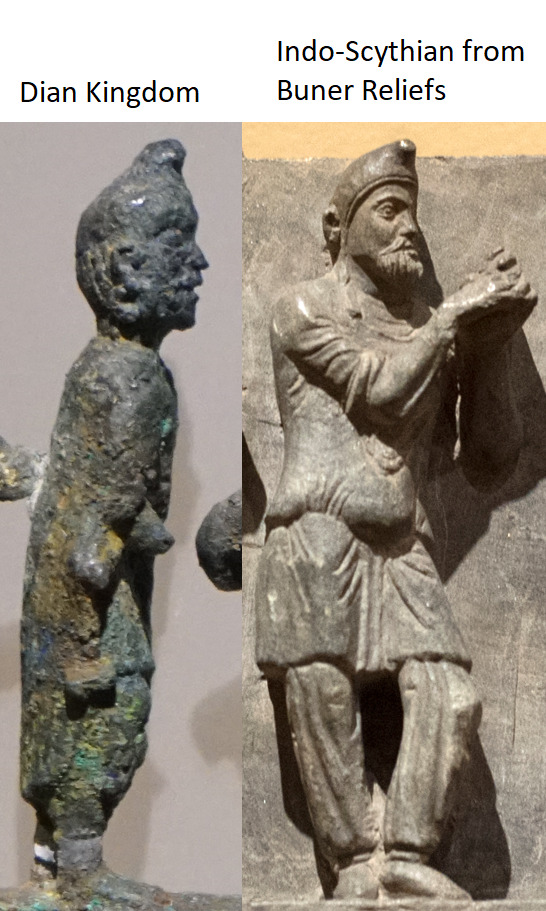


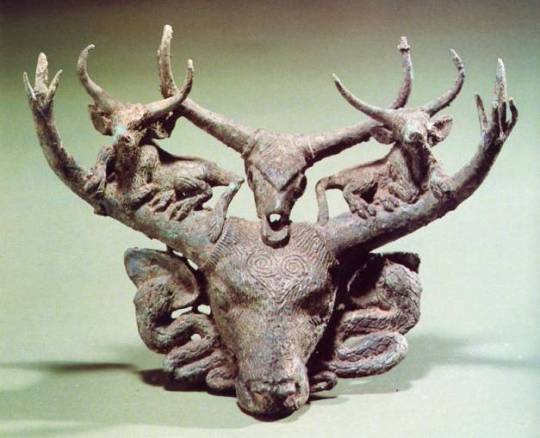
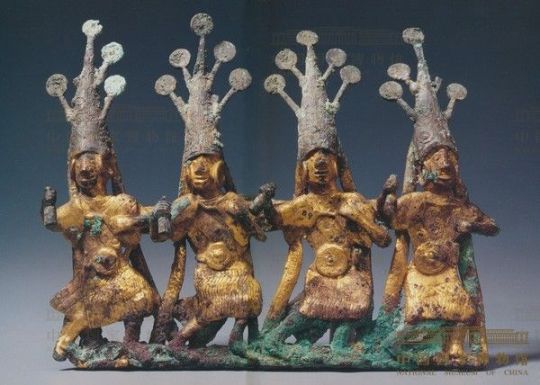

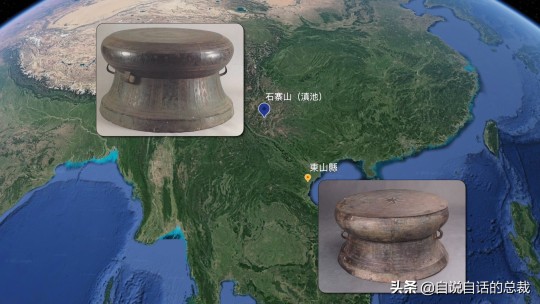
Dian Kingdom 8th-1st C. BCE. Meant to post this one a long time ago but it took me forever to put together. I'm just going to post 30 images here, I got about 100 total on my blog. Link at bottom.
The Dian Kingdom was an advanced civilization in what is modern-day southwest China. It was occupied by the Han Dynasty and incorporated into China after that. From what I've gathered, the people of the Dian Kingdom were probably closely related to the Baiyue people from southern China and northern Vietnam. Wikipedia says they may have spoke a Tibeto-Burman language. I found it interesting that some of these people look Caucasoid though and were wearing clothing similar to Scythians. The image I compared of the Dian man to the Indo-Scythian has a similar facial structure, hat, and even the same type of pants (sorry, I don't have time to tidy up the comparison photos more).
The Dian art theme of the four tigers attacking an ox is found in the same pre-Han period among the Xiongnu at Aluchaideng, and a similar motif appears at Tillya Tepe a couple centuries later. The theme is the same but the style is very different, still it indicates a connection to these places of the world through trade and exposure.
Some of the scenes with soldiers show a variety of different equipment styles and certain subjects have distinct fashion styles (like the people wearing the items that make their ears look huge). I watched a couple documentaries on genetics of the Dian and they were only able to find genetic info for one person, who was identified as similar to the Baiyue people. I'll link those youtube videos in sources below. I assume these people were primarily related to modern day Vietnamese and southern Chinese (or other people nearby) but may have had close interactions with (and even immigrants from) Scythian cultures despite their distance from them, which is interesting.
From the videos: "According to the final count, the amount of bronze ware excavated from Lijia Mountain is almost half the amount of the Shang Dynasty bronze ware excavated in Yinxu, Henan."
youtube
youtube
#ancient history#history#museums#art history#art#sculpture#statue#ancient china#china#vietnam#scythian#artifacts#antiquities#anthropology#archaeology#indo european#Youtube
300 notes
·
View notes
Note
My favorite example of "space tamales" with MENA/SWANA characters was in a fic where an author described Farsi as "a dialect of Arabic." My sister in Christ, they are not even related languages. Farsi is Indo-European (like English is) and Arabic is a Semitic language. The author claimed to be "really passionate about language learning" too, but apparently not passionate enough to just look up 101 stuff about these two major world languages on Wikipedia....
Another thing I see a lot with Asian (especially outside of China/Korea/Japan), African and SWANA cultures in particular in fic is this thing where the "traditional cultural elements" means they're luddites compared to everybody else. Like space futures where the Middle-Eastern character's family are still living in desert caravans with no modern tech or the African character's are doing that in some stereotype of a rural village with no running water or electricity.
Like you'd have hoped that the internationally popular movie Black Panther would've introduced more people to the fact that Afrofuturism = thing that exists, and more broadly that you can do a high-tech, spacefaring future that is culturally non-Western and what that might look like.... and yet people still get stuck on this.
The only non-Western cultures they seem to be able to envision as futuristic are (sometimes) East Asian ones, probably because of cyberpunk and anime.
It makes me want to see a reversal of this sometime. The non-white/Western characters' homes are these super futuristic megalopolises with flying cars, but you follow the French character home and it's still like pre-revolutionary Paris with giant wigs and horses-and-carriages and no indoor plumbing for some reason.
--
A DIALECT OF ARABIC?!?!
And the space!French will 10000% have a bunch of places that make wine in a 1700s way and are extremely annoying about it.
105 notes
·
View notes
Text
Escalating Tensions in the East China Sea: Japan's Concerns
Japan has raised serious concerns over the increasing activity of Chinese vessels near the disputed Senkaku Islands. Japanese Foreign Minister Takeshi Iwaya emphasized that the presence of Chinese Coast Guard ships is “clearly escalating.” This was particularly evident during a recent intrusion that lasted over 92 hours, marking the longest encroachment into Japanese territorial waters since…
#china#Chinese Coast Guard#East China Sea#geopolitical analysis#Indo-Pacific#International Relations#japan#Japan-China relations#Maritime Security#naval exercises#Senkaku Islands#South Korea#territorial disputes#U.S. Navy#USS Carl Vinson
1 note
·
View note
Text

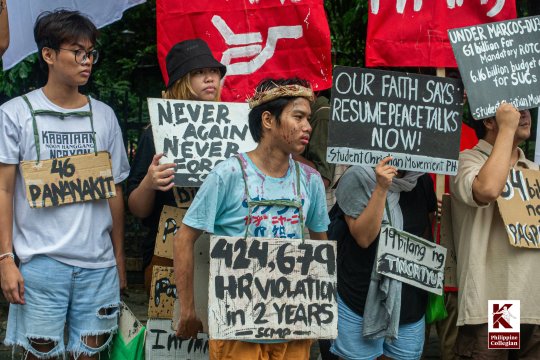


LOOK: Multisectoral groups marched along Commonwealth Avenue earlier today as President Ferdinand Marcos Jr. delivered his third State of the Nation Address (SONA) at the Batasang Pambansa to assail his failed promise of a Bagong Pilipinas [trans. New Philippines]. For the groups, Marcos’s Bagong Pilipinas is a grand sham. Amid promises of better living conditions, 46 percent of Filipinos rated their families as food poor—the highest since 2008—according to the latest survey of Social Weather Stations. “[H]inaharap [ng ating mga kababayan] ang realidad na mataas ang presyo ng mga bilihin, lalo na ng pagkain—lalo’t higit, ng bigas,” said Marcos in his speech earlier, affirming bleak realities on the ground. On top of a cost of living crisis are poverty wages that fail to meet the family living wage of P1,190, as estimated by economic think tank IBON Foundation, the P35 wage hike in the National Capital Region (NCR) enacted last week was dismissed as an “insult to minimum wage workers” by Leticia Castillo of human rights alliance Defend NCR. Such wage hike is far from the P150 raise being lobbied in Congress by labor groups under the National Wage Coalition. Castillo also decried the persistence of red-tagging and vilification of activists perpetrated by the National Task Force to End Local Communist Armed Conflict. From July 2022 to June 2024, 3,419,044 cases of threat, harassment, and intimidation were recorded by human rights group Karapatan. The number of political prisoners also climbed to 755 as of last month. These human rights violations run contrary to Marcos’s establishment of a Special Committee on Human Rights, which was labeled “toothless” by Human Rights Watch. Marcos’s claim of a bloodless drug war is also inconsistent with the 359 drug-related killings—34.3 percent of which were committed by state agents—recorded during his second year in office by research project Dahas. Moreover, despite claims of an independent foreign policy, the Philippines under Marcos remains dependent on the US and its unequal treaties, said Liza Maza of MAKABAYAN. Last year, Marcos announced the creation of four new US military bases in the country under the Enhanced Defense Cooperation Agreement with the US. Such treaties with the US have been criticized for intensifying tensions with China and the broader Indo-Pacific region. Clarice Palce of Gabriela and Ronnel Arambulo of Pamalakaya raised their worries of the Philippines being dragged into a stand off between two global superpowers which will only worsen the poor living conditions of Filipinos. The program ended with a symbolic destruction of the effigies of Marcos and Vice President Sara Duterte. The broken UniTeam will be challenged by the Makabayan Coalition which will field a complete senatorial slate including ACT Teachers Party-list Representative France Castro and Gabriela Women’s Party Representative Arlene Brosas in the 2025 midterm elections. Photos by AJ Dela Cruz, Marcus Azcarraga, Audrey Sanchez, and Sarah Gates
-- Philippine Collegian, 22 Jul 2024 9:45pm PHT
42 notes
·
View notes
Note
Books you would recommend on this topic? Colonial, post colonial, and Cold War Asia are topics that really interest me. (Essentially all of the 1900s)
Hello! An entire century is huge and I don't quite know what exactly you're looking for, but here we are, with a few books I like. I've tried organising them, but so many of these things bleed into each other so it's a bit of a jumble
Cold War
1971 by Srinath Raghavan: about the Bangladesh Liberation War within the context of the Cold War, US-Soviet rivalry, and the US-China axis in South Asia
Cold War in South Asia by Paul McGarr: largely focuses on India and Pakistan, and how the Cold War aggravated this rivalry; also how the existing tension added to the Cold War; also the transition from British dominance to US-Soviet contest
Kennedy, Johnson, and the Nonaligned World by Robert B. Rakove: on the US' ties with the Nonaligned countries during decolonisation and in the early years of the Cold War; how US policy dealt with containment, other strategic choices etc
South Asia's Cold War by Rajesh Basrur: specifically about nuclear buildup, armament and the Indo-Pak rivalry within the larger context of the Cold War, arms race, and disarmament movements
Colonialism
India's War by Srinath Raghavan: about India's involvement in World War II and generally what the war meant for South Asia politically, economically and in terms of defense strategies
The Coolie's Great War by Radhika Singha: about coolie labour (non-combatant forces) in the first World War that was transported from India to battlefronts in Europe, Asia and Africa
Unruly Waters by Sunil Amrith: an environmental history of South Asia through British colonial attempts of organising the flow of rivers and the region's coastlines
Underground Revolutionaries by Tim Harper: about revolutionary freedom fighters in Asia and how they met, encountered and borrowed from each other
Imperial Connections by Thomas R. Metcalf: about how the British Empire in the Indian Ocean was mapped out and governed from the Indian peninsula
Decolonisation/Postcolonial Asia
Army and Nation by Steven Wilkinson: a comparative look at civilian-army relations in post-Independence India and Pakistan; it tries to excavate why Pakistan went the way it did with an overwhelmingly powerful Army and a coup-prone democracy while India didn't, even though they inherited basically the same military structure
Muslim Zion by Faisal Devji: a history of the idea of Pakistan and its bearing on the nation-building project in the country
The South Asian Century by Joya Chatterji: it's a huge book on 20th century South Asia; looks at how the subcontinental landmass became three/four separate countries, and what means for history and culture and the people on the landmass
India Against Itself by Sanjib Baruah: about insurgency and statebuilding in Assam and the erstwhile NEFA in India's Northeast. Also see his In the Name of the Nation.
I hope this helps!
54 notes
·
View notes
Text
Finnish words by unusual language of origin
*note: this does not list all the languages that the word was borrowed from, only the oldest known origin of it
*also: if you've never seen a word on this list, please don't doxx me. These are all real words. I don't spread misinformation. Why do I still need to put this in my posts
Job: Ammatti (from proto-celtic *ambaxtos) Fun Fact: this is the same root that forms the english word “Ambassador”!
Wagon: Kärry (from proto-celtic *karros) Fun Fact: This is the root that forms the English word “Car”!
Poem: Runo (from proto-celtic *rūnā) Fun Fact: This is the root that forms the English word “Rune”!
Hikikomori: Hikky (from Japanese hikikomori 引き籠もり)
Clam: Simpukka (from Mandarin zhēnzhū 珍珠)
Goods: Tavara (from proto-turkic *tabar) Fun Fact: words descended from this root can be found as far as China and Siberia!
Dungeon, jail: Tyrmä (from proto-turkic *türmä) Fun Fact: This toot extends to Azerbaijan and even Yiddish!
Rauma (city name) (from proto germanic *straumaz meaning stream)
Cherry: Kirsikka (from ancient creek kerasós κερασός which might also have older forms) Fun Fact: this word is widespread, even appearing in Arabic.
God: Jumala (possibly from proto-indo-iranian) Fun Fact: This word could be related to Sanskrit dyumna द्युम्�� if it is from proto-indo-iranian
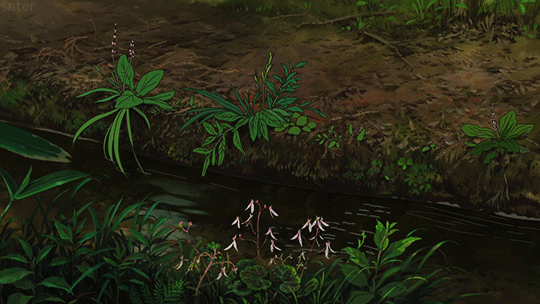
#finnish#langblr#langblog#language#study blog#suomen kieli#finnish language#finnish langblr#word roots#proto-celtic#proto-turkic#germanic#celtic#indo-iranian
102 notes
·
View notes